One of the best and important archaeological centers in the world is the West Bank of Luxor. It has an area of about 9 square kilometers, including the popularly known Valley of the Kings, the stunning Tomb of Queen Nefertari in the Valley of the Queens, and the temples of ancient Egyptian pharaohs. The most impressive of these is the mortuary temple of Queen Hatshepsut, Habu, and a large number of Nobel tombs and so on.
The western side of Luxor has more archaeological sites to visit during your Luxor tour than the eastern side. Several mortuary temples of the pharaoh, ornamental graves of the nobility, and the workers’ village of Deir el-Medineh caught the attention of travelers.
Traveling to West Bank of Luxor
1- Airport
After touching down, the next thing is to board a taxi; you should take a taxi at a reasonable price of EGP100. It’s easy to take a taxi when you arrive, but if you’re not an expert in negotiation, it’s best to arrange a pick-up service from your hotel in advance. You can Anticipate paying between EGP 50 and EGP 100 for this 20km journey, depending on your negotiating skills.
2- Train station
Taxis are easily accessible; however, if you have a small budget and are mobile enough, you only need to take a little walk to the ferry jetty. Just go up the al-mahatta and go around the top of Luxor Temple to get there. A taxi ride from the train station to the jetty should cost around 10 EGP. Hotels in the West Bank are easily accessible from the jetty.
3- Using ferry from the East Bank
The fastest, most authentic, and most romantic way to cross the Nile to the west is using a ferry or motorboat. Until recently, there were two ferries: a tourist ferry (now replaced by the road bridge) and a local ferry for residents (Baladi ferry). The Baladi ferry secures EGP5 for foreigners, EGP1 for locals, and leaves from its dock beside the Luxor Museum. There is no set time: ferries disappear when they are full or when it has been there for a long time.
Try to smile and talk to the locals – after all, you will use their ferry! But beware of a few high-pressure vendors who may be on board hoping to lure you for taxi or accommodation deals. Carefully consider their offer, don’t hesitate to haggle. And if you are not pleased with their offer, No, thank you “( la Shukran) should do the work.
Motor launches don’t have a fixed docking station – they go where they can pick up a customer. Prices should be about EGP5-7 per person and EGP1-1.50 if you are traveling with some group of people (at least 5 in a group). The benefit of using a motor launch, of course, is that you can start going right away.
Getting Around West Bank of Luxor

1- Taxi
The places on the West Bank of Luxor are scattered, and the temperature varies from hot to very hot, so the most convenient way to move around is by hiring a taxi for the whole day. This will cost you about EGP250 from the East Bank and around EGP100-150 from the West Bank. For a return trip ticket to a designated place, the price of a minibus with a maximum of 9 people cannot exceed an EGP100.
If you deem yourself as good in negotiations, it will be cost-effective to personally hire a taxi. Otherwise, you can ask your hotel to arrange a taxi, to avoid any regrets. Bargaining is absolutely necessary because, in Egypt, the first price is always high.
2- Bicycle
You can get bicycles at the hotels around EGP10-20 for a day and also closer to the ferry jetty. Keep in mind that the heat can be intense, and bikes can be primitive. Take along a lot of water. Even with a bicycle, you cannot walk through the hills between different valleys.
3- Pickups
The normal pick-up leaves for Gurna from the ferry, and if you can get one, you can go there for less than EGP 1. Please note, however, that locations are generally 0.5-1 km from the main road, then you will have to find your way there walking. The most advisable way to use pick-ups is taking one to old Gurna, trek/hitch a ride along the road to Deir al-Bahri, then hike through the mountains to the Valley of the Kings and then back to Deir Al-Medina and disembark in New Gurna to take a pick-up ride to the jetty.
4- On foot
After getting to the tomb by taxi or bus, it’s okay to walk through the hills between each area. Small police stations were set up in the hills and should not obstruct pedestrians. The path ascending from Deir el-Bahari is outside the ticket office on the way. The path that leads to Valley of the Kings is behind KV42, closer to the sign “No Climbing Mountain”. There are also walking trails to Queen’s Valley, Deir el Medineh and Gurna located outside the ticket office. And keep in mind to do all this with your water with you!
5- Donkey
For an incredible experience, ride a donkey or ride through a part of the West Bank of Luxor villages where people live and have a glimpse of their daily lives. You get a lot of smiles and waves (particularly from children), and you won’t get to see anyone trying to make you buy something. Head to Stables of Pharaoh and follow the signs to Amon Hotel.
It’s within walking distance of the ferry terminal, so you might not need a taxi! They also have excellent horse riding, and it is possible to visit some of the temples on horseback. An Evening sunset trip is an unmissable experience. They’ll show you places where big buses can’t reach you, and you’ll get to experience the real Egypt and its welcoming people.
Things to do and Where to Go in West Bank of Luxor
The Valley of the Kings is a royal cemetery for pharaohs dated back to the 18th, 19th, and 20th dynasties. Over sixty-two stone tombs from the 16th and 11th centuries BC Built to contain the dead pharaohs from the New Kingdom there.
The valley has two distinct arms – the Western Valley and the Eastern Valley. Most tombs are on this latter arm. Although the remains of nearly all of them have been taken as antiquity, the murals and hieroglyphics on the walls of royal tombs offer priceless information about burial rituals and ancient Egyptian beliefs.
Out Of all these tombs at the Valley of the Kings, few are open to the public. There are currently eight tombs available for sightseeing in the Valley of the Kings. You can visit three of the tombs using your entrance ticket. If you want to have access to other graves other than three graves, you need to buy an extra ticket.
1- Mortuary Temple of Queen Hatshepsut West Bank of Luxor
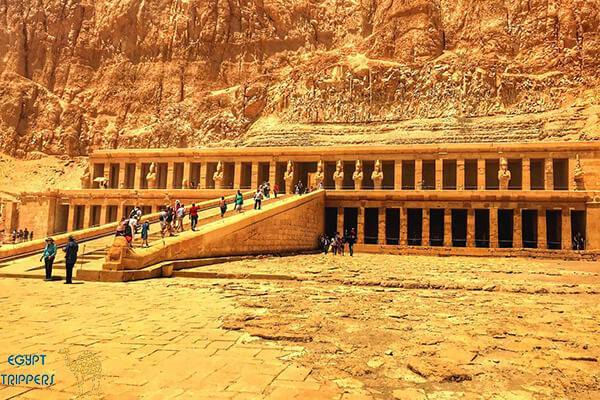
Like Cleopatra, Queen Elizabeth I, and Catherine, the Great of Russia, Hatshepsut is one of the most powerful female leaders in the world. He ruled Egypt for about 20 years. He brought good luck to Egypt, which made several of her architectural projects possible.
On the hill of Deir el-Bahri in the Mortuary Temple of Hatshepsut, which is her most famous architectural work, this colonnaded structure looks very different from many other temples in Egypt, but this is why it is so memorable.
There is a connection among three terraces by long ramps. This temple complex features the birth pillar, which narrates the story of the divine creation of Hatshepsut with Amun (her father). The Punt Colonnade tells the story of her expedition to Punt, and the expensive goods are taken back to Egypt. In addition, you will see the Temple of Hathor and the Temple of Anubis.
This is one of the most popular attractions in Luxor’s West Bank, so it’s always fully crowded in mid-day.
2- The Temple of Habu or Madinat Habu
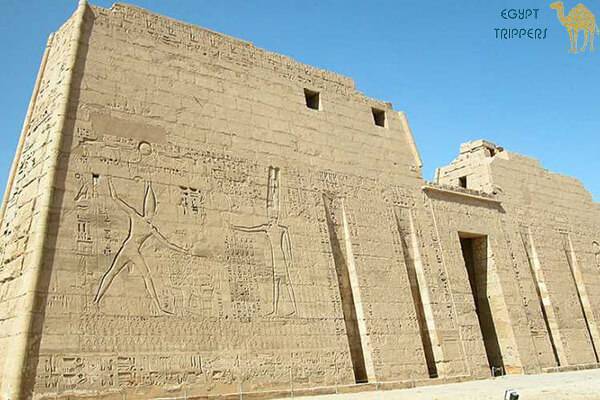
This is one of the best temples you can find in Egypt, and it has successfully retained its ancient colors. The great temple of the last mighty Pharaoh King Ramses III, the temple of Madinat Habu. It is considered one of the main attractions in Luxor.
The temple has two pillars or the Triumph Gate, as the military scenes carved into the walls depict the pharaoh sacrificing his enemy to the god Amun. So when you go through this gate, you’re in an open court used for festivals, and it features interesting inscriptions and very deep reliefs, the deepest in the temples in Egypt.
3- Valley of the Queens

The Valley of the Queens is the grave of the different wives of the pharaohs. The tombs you see here are relatively small and not as large as the tombs in the Valley of the Kings, with one notable exception.
In West Bank of Luxor, the tombs in Queens Valley are mostly for the 19th and 20th dynasties. There are about 80 tombs known today, most of them excavated between 1903 and 1905 by an Italian (E. Schiaparelli) expedition.
Most of these tombs are not furnished and unadorned, like caves in the rock. There are several inscriptions or relief pieces and many decorative paintings on stucco. There are only four of the tombs accessible to the public, but one of them is the famous Nefertari Tomb, which reopened in 2016, so it’s worth taking making a trip to the valley.
The tomb of Queen Nefertari (wife of Ramses II) is considered the most beautiful tomb in West Bank of Luxor. The interior of the rooms is covered with detailed and colorful views, celebrating the legendary beauty of Nefertari.
Out of the three tombs that are accessible to the public, the best one you can see is the Tomb of Prince Amen-her-khopshef because the paintings of its rooms feature radiant and preserved colors. He was a son to Ramses III, and he died while he was very young (teenager).
4- Ramesseum
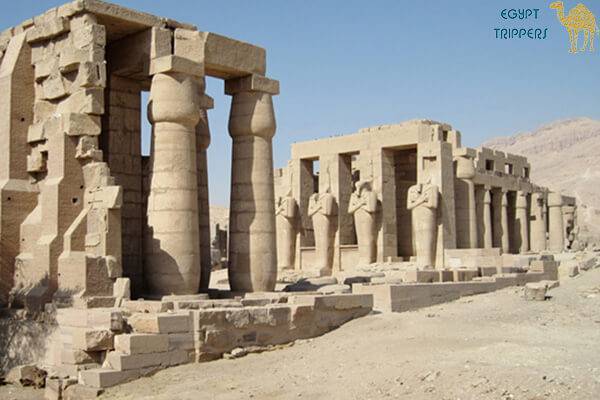
The large mortuary temple, dedicated to Amun, was constructed by Ramses. It is located along with the cultivated land, a few kilometers in the south of Deir el-Bahri. Although about half of the initial structure was not preserved, it is still an extremely exciting monument.
In the Roman Empire, it was called the tomb of Ozymandias. It was mentioned in the 1st century BC by the historian Diodorus. It was later mentioned by the English poet Shelley in his poem titled Ozymandias. Like Abu Simbel’s relief, the north and south towers are carved with reliefs from the battle between Ramses II and the Hittites.
In the South Tower, the Battle of Qadesh occupies the left half of the wall. Here, the scene is Ramesses riding a chariot against the Hittites, killing them with his arrows or escaping in a difficult situation, and falling into the River Orontes. You can see the Hittite prince and enemies on the right escaping to their stronghold. There are the remains of the king’s colossal figure in the first court, which was originally estimated to be 17.5 meters high and weighing over 1,000 tons.
5- Deir El-Medina – Valley of the Artisans

The artisans working in the tombs of the Valley of the Kings lived in an old village in Deir el-Medina. There are also tombs built here for some workers that are found to be famous.
Same as the Valley of the Queens, these tombs are not that big and less gorgeous than the ones in the Valley of the Kings; however, if you stay in the West Bank for two days, it is still worth visiting this site.
6- Hot Air Balloon Ride

If you can sacrifice getting up early out of bed at dawn and can take a hot air balloon at sunrise, get a bird’s eye view of the West Bank.
The hot air balloon starts after sunrise and flies over the west bank. Then you get to have a view of the green farmland scattered among barren escarpments, the temples area, and tomb sites.
Generally, the flight time is about 45 minutes, but it is expected that the hot air balloon flight experience from the hotel then coming back there to take about three hours.
There are various operators in the city. Group trips with balloons usually use bigger baskets that can accommodate approximately 24 passengers with the pilot.
7- Medinet Habu
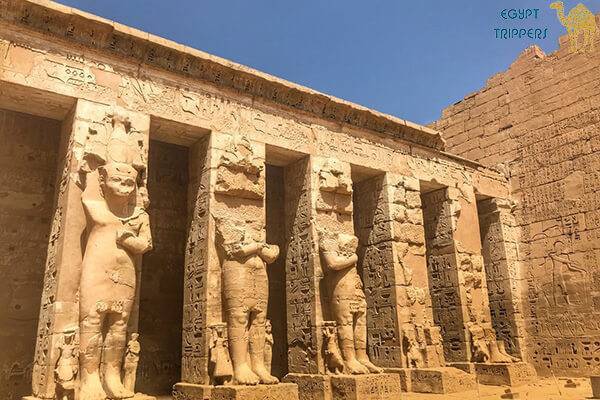
Having some main attractions like the famous Valley of the Kings and the Temple of Deir al-Bahri. Medinet Habu does not always get many attractions when traveling to the West Bank, but it is one of the best-decorated temples in Egypt and should be on your favorite list while visiting West Bank of Luxor.
The complex comprises a small, ancient temple built in the 18th dynasty and later expanded at the end of the period. The large temple of Ramses III is attached to a royal palace, surrounded by a four-meter-high battlemented wall complex.
The temple’s main area was built directly to model the Ramesseum and was also dedicated to Amun, the same as the Ramesseum. You don’t want to miss the reliefs here, as they are some of the best you find in West Bank of Luxor.
8- Tombs of the Nobles in West Bank of Luxor
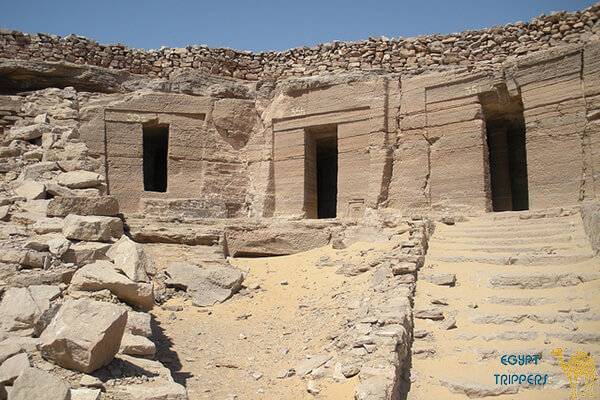
If you are not satisfied with the tombs in the Valley of the Kings, head to the Tomb of the Nobles; it may not be so famous but is a better example of a tomb with preserved paintings. In this region of thWest Bank of Luxor, which stretches from the sixth dynasty to the Ptolemaic period, there are about 400 tombs with various significant figures.
The tomb paintings here are not focused on giving guidance to the dead as they journey to the afterlife but depict scenes from everyday life in Egypt.
Particularly, Sennofer’s Tomb, Rekhmire’s Tomb, Khonsu’s Tomb, Benia’s Tomb, Menna’s Tomb, and the Tomb of Nakht host some of the most vivid and exciting tomb paintings in Egypt.
If you don’t have enough time, visit Sennofer’s tomb and Rekhmire’s tomb. Both feature highly detailed images that depict scenes from men’s everyday, professional, and family life. Sennofer was overseer in the reign of Amenhotep II, and Rekhmire was the vizier to pharaoh.
9- Tutankhamun’s tomb replica and Carter’s home

Carter settled in this simple adobe house during a long search of Tutankhamun’s tomb. Here, in the garden, you can see a precise replica of Tutankhamen’s tomb from the Valley of the Kings.
A replica of the tomb was modeled just like the original, down to the smallest detail; this includes the dust. In association with the Egyptian Ministry of Antiquities, Factum Foundation for Digital Conservation created the tomb as a contemporary conservation experiment.
There is a significant number of tourists that intentionally travel to Egypt every year to see the tomb and temples. However, at the same time, the footfall in the delicate atmosphere of the tomb greatly reduces its status. Come here to marvel at the perfection of the copy and think about how such a copy can be used to protect the original site in the future.
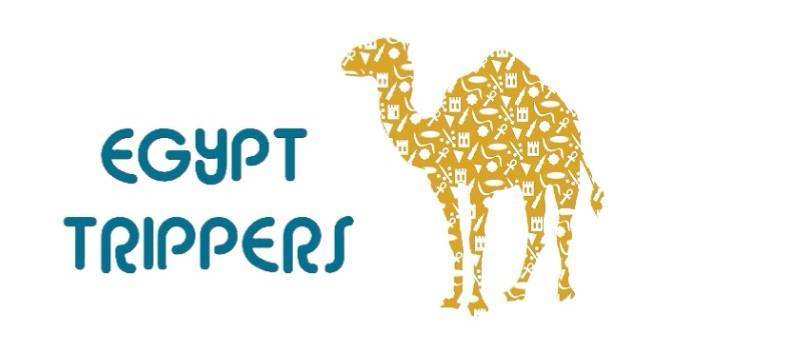


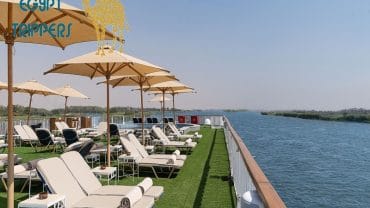

Comment (0)